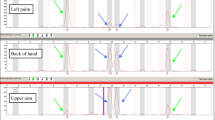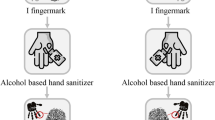Abstract
Contact traces on a human body are a widespread object investigated in cases involving criminal acts against a person. In such cases, interpretation of the results of DNA analysis, as the most evident method, is accompanied by considerable difficulties. This paper shows the possibility of detecting genetic material in the sweat and grease deposits left by the donor on the skin surface of a living recipient. The comparative study of DNA amount in the sweat and grease substance on the surface of the skin of different areas of the body of men and women is carried out. Typing of microsatellite loci of autosomal DNA and Y chromosome in swabs from places of contact of donor males with integuments of recipients of both sexes is carried out. No statistically significant differences in the DNA amount of sweat and grease substance depending on its localization on human body are revealed. The DNA study of sweat and grease substance left by donor men on the skin of both men and women in half of cases reveals allelic combinations inherent in both the donor and the recipient. The results obtained indicate equal chances of detecting the DNA of contacting individuals.
Similar content being viewed by others
References
Goryanov, Yu.I., Identification of a person by DNA: analysis of practice and prospects for its development, Ugolovnyi protsess (Criminal Process), Moscow: Aktion-Media, 2010, vol. 68, no. 8, pp. 68–73.
Belykh, A.N., Forensic medical characterization of strangulation methods by the unarmed person by pressure on the neck with limbs, Ekspert–Kriminalist, 2008, no. 4, pp. 26–28.
Podporinova, E.E., Forensic examination of manual strangulation, Extended Abstract of Cand. Sci. Dissertation, St. Petersburg Gos. Med. Akad., St. Petersburg, 1997.
Moiseeva, T.F., Methodology of complex forensic research of sweat and grease deposits of a person, Doctoral (Legal Science) Dissertation, Moscow, 2002.
Feingold, K.R., Thematic review series: skin lipids. The role of epidermal lipids in cutaneous permeability barrier homeostasis, J. Lipid Res., 2007, vol. 48, pp. 2531–2546. doi 10.1194/jlr.R700013-JLR200
Kumar, P., Gupta, R., Singh, R., and Jasuja, O.P., Effects of latent fingerprint development reagents on subsequent forensic DNA typing: a review, J. Forensic Leg. Med., 2015, vol. 32, pp. 64–69. doi 10.1016/j.jflm. 2015.03.002
Faleeva, T.G., Sweat and grease deposits as an object of DNA identification of a person, Vestn. Severo-Zapad. Gos. Med. Univ. im. I.I. Mechnikova, 2017, vol. 9, no. 2, pp. 78–84.
Tozzo, P., Giuliodori, A., Rodriguez, D., and Caenazzo, L., Effect of dactyloscopic powders on DNA profiling from enhanced fingerprints: results from an experimental study, Am. J. Forensic Med. Pathol., 2014, vol. 35, no. 1, pp. 68–72. doi 10.1097/PAF. 0000000000000081
Raymond, J.J., van Oorschot, R.A.H., Gunn, P.R., et al., Trace DNA success rates relating to volume crime offences, Forensic Sci. Int.: Gen. Suppl. Ser., 2009, pp. 136–137. doi 10.1016/j.fsigss.2009.08.072
Goray, M., Mitchell, R.J., and van Oorschot, R.A.H., Investigation of secondary DNA transfer of skin cells under controlled test conditions, Legal Med. (Tokyo), 2010, vol. 12, no. 3, pp. 117–120. doi 10.1016/j.legalmed. 2010.01.003
Lowe, A., Murray, C., Whitaker, J., et al., The propensity of individuals to deposit DNA and secondary transfer of low level DNA from individuals to inert surfaces, Forensic Sci. Int., 2002, vol. 129, no. 1, pp. 25–34. doi 10.1016/S0379-0738(02)00207-4
Rutty, G.N., An investigation into the transference and survivability of human DNA following simulated manual strangulation with consideration of the problem of third party contamination, Int. J. Legal Med., 2002, vol. 116, no. 3, pp. 170–173. doi 10.1007/s00414-001-0279-2
Phipps, M. and Petricevic, S., The tendency of individuals to transfer DNA to handled items, Forensic Sci. Int., 2007, vol. 168, nos. 2–3, pp. 162–168. doi 10.1016/j.forsciint.2006.07.010
Färber, D., Seul, A., Weisser, H.-J., and Bohnert, M., Recovery of latent fingerprints and DNA on human skin, J. Forensic Sci., 2010, vol. 55, no. 6, pp. 1457–1461. doi 10.1111/j.1556-4029.2010.01476.x
Gutiérrez-Redomero, E., Alonso, C., Romero, E., and Galera, V., Variability of fingerprint ridge density in a sample of Spanish Caucasians and its application to sex determination, Forensic Sci. Int., 2008, vol. 180, no. 1, pp. 17–22. doi 10.1016/j.forsciint.2008.06.014
Gungadin, S.M., Sex determination from fingerprint ridge density, Internet J. Med. Update, 2007, vol. 2, no. 2, pp. 1–4. doi 10.4314/ijmu.v2i2.39847
Nayak, V.C., Rastogi, P., Kanchan, T., et al., Sex differences from fingerprint ridge density in Chinese and Malaysian population, Forensic Sci. Int., 2010, vol. 197, nos. 1–3, pp. 67–69. doi 10.1016/j.forsciint. 2009.12.055
Faleeva, T.G., Mishin, E.S., Ivanov, I.N., and Kornienko, I.V., A comparative study of the methods of extracting and isolating DNA from the flush overlays that are on a surface of metal objects (based on the results of forensic molecular genetic examination), Trudy Peterburgskogo nauchnogo obshchestva sudebnykh medikov (teoriya i praktika sudebnoi meditsiny) (Proceedings of the Petersburg Scientific Society of Forensic Medicine (Theory and Practice of Forensic Medicine)), Ivanov, I.N., Ed., St. Petersburg: Beresta, 2015, issue 11, pp. 124–127.
Faleeva, T.G., Ivanov, I.N., Mishin, E.S., and Kornienko, I.V., Metodika sbora i probopodgotovki potozhirovykh sledov cheloveka dlya molekulyarno-geneticheskogo issledovaniya: uchebno-metodicheskoe posobie (Methods for Collecting and Preparing Samples of Human Sweat and Grease Deposits for Molecular Genetic Investigation: A Study Guide), St. Petersburg: Severo-Zapad. Gos. Med. Univ. im. I.I. Mechnikova, 2017.
Kornienko, I.V. and Kharlamov, S.G., Metody issledovaniya DNK cheloveka: vydelenie DNK i ee kolichestvennaya otsenka v aspekte sudebno-meditsinskogo issledovaniya veshchestvennykh dokazatel’stv biologicheskogo proiskhozhdeniya: uchebno-metodicheskoe posobie (Methods for the Study of Human DNA: The Isolation of DNA and Its Quantification in the Aspect of Forensic Investigation of Physical Evidence of Biological Origin: A Study Guide), Rostov-on-Don: Yuzhnyi Federal’nyi Universitet, 2012.
Faleeva, T.G., Ivanov, I.N., Mishin, E.S., et al., Problems of molecular-genetic identification of human sweat and grease deposits in personal fingerprints, Sudebno-Med. Ekspertiza, 2016, vol. 59, no. 2, pp. 14–18. doi 10.17116/sudmed201659214-18
COrDIS Plus: Nabor reagentov dlya mul’tipleksnogo analiza 19-ti STR-markerov i lokusa amelogenina cheloveka: instruktsiya pol’zovatelya (COrDIS Plus: A Set of Reagents for the Multiplex Analysis of 19 STRMarkers and Human Amelogenin Locus: User’s Guide), GORDIZ, 2014.
COrDIS Y: Nabor reagentov dlya mul’tipleksnogo analiza 18-ti STR-markerov khromosomy Y cheloveka: instruktsiya pol’zovatelya (COrDIS Y: A Set of Reagents for the Multiplex Analysis of 18 Y Chromosome STR-Markers: User’s Guide), GORDIZ, 2011.
Butler, J.M., Advanced Topics in Forensic DNA Typing: Methodology, Amsterdam: Elsevier, 2012.
Kulaichev, A.P., Metody i sredstva analiza dannykh v srede Windows: Stadia 6.0 (Methods and Tools for Data Analyzing in a Windows Environment: Stadia 6.0), Moscow: Informatika i Komp’yutery, 1996.
Butler, J.M., Fundamentals of Forensic DNA Typing, Gaithersburg, Maryland: National Institute of Standards and Technology, 2010, pp. 330–334.
Gistologiya, tsitologiya i embriologiya: uchebnik (Histology, Cytology, and Embryology: A Guidebook), Afanas’ev, Yu.I., Kuznetsov, S.L., and Yurina, N.A., Eds., Moscow: Meditsina, 2006, 6th ed.
Bykov, V.L., Chastnaya gistologiya cheloveka: uchebnik (Human Special Hystology: A Guidebook), St. Petersburg: SOTIS, 1999.
Kita, T., Yamaguchi, H., Yokoyama, M., et al., Morphological study of fragmented DNA on touched objects, Forensic Sci. Int. Genet., 2008, vol. 3, no. 1, pp. 32–36. doi 10.1016/j.fsigen.2008.09.002
Quinones, I. and Daniel, B., Cell free DNA as a component of forensic evidence recovered from touched surfaces, Forensic Sci. Int. Genet., 2012, vol. 6, no. 1, pp. 26–30. doi 10.1016/j.fsigen.2011.01.004
Ob utverzhdenii poryadka organizatsii i proizvodstva sudebno-meditsinskikh ekspertiz v gosudarstvennykh sudebno-ekspertnykh uchrezhdeniyakh Rossiiskoi Federatsii (About the Statement of the Order of the Organization and Proceedings of Forensic Medical Examinations in the State Forensic Expert Institutions of the Russian Federation), Prikaz Minzdravsotsrazvitiya Rossii ot 12 maya 2010 g, no. 346n (Order of the Ministry of Health and Social Development of Russia, May 12, 2010, no. 346n) Moscow, 2010.
Farash, K., Hanson, E.K., and Ballantyne, J., Enhanced genetic analysis of single human bioparticles recovered by simplified micromanipulation from forensic ‘touch DNA’ evidence, J. Vis. Exp., 2015, vol. 97. e52612. doi 10.3791/52612
Daly, D.J., Murphy, C., and McDermott, S.D., The transfer of touch DNA from hands to glass, fabric, and wood, Forensic Sci. Int. Genet., 2012, vol. 6, no. 1, pp. 41–46. doi 10.1016/j.fsigen.2010.12.016
Djuric, M., Varljen, T., Stanojevic, A., and Stojkovic, O., DNA typing from handled items, Forensic Sci. Int.: Gen. Suppl. Ser., 2008, vol. 1, pp. 411–412.
Author information
Authors and Affiliations
Corresponding author
Additional information
Original Russian Text © T.G. Faleeva, I.N. Ivanov, E.S. Mishin, E.E. Podporinova, A.O. Pravodelova, I.V. Kornienko, 2018, published in Genetika, 2018, Vol. 54, No. 6, pp. 727–734.
Rights and permissions
About this article
Cite this article
Faleeva, T.G., Ivanov, I.N., Mishin, E.S. et al. Possibilities of DNA Identification of Foreign Sweat and Grease Substance on Human Skin. Russ J Genet 54, 746–752 (2018). https://doi.org/10.1134/S1022795418060054
Received:
Accepted:
Published:
Issue Date:
DOI: https://doi.org/10.1134/S1022795418060054




